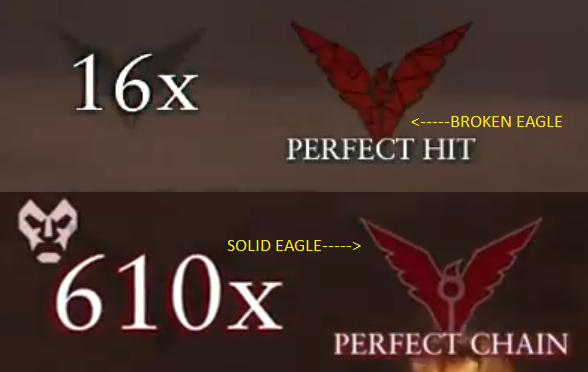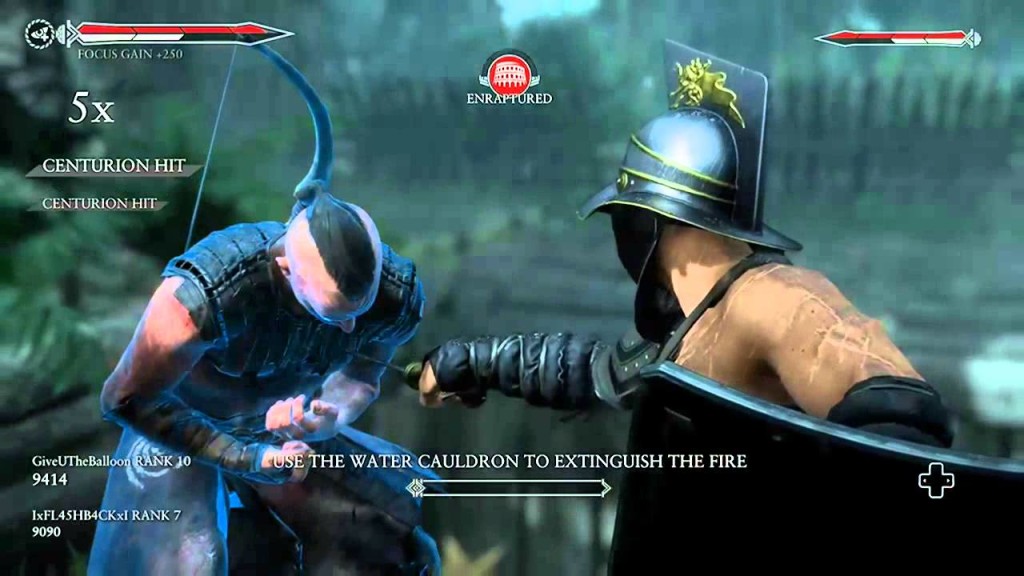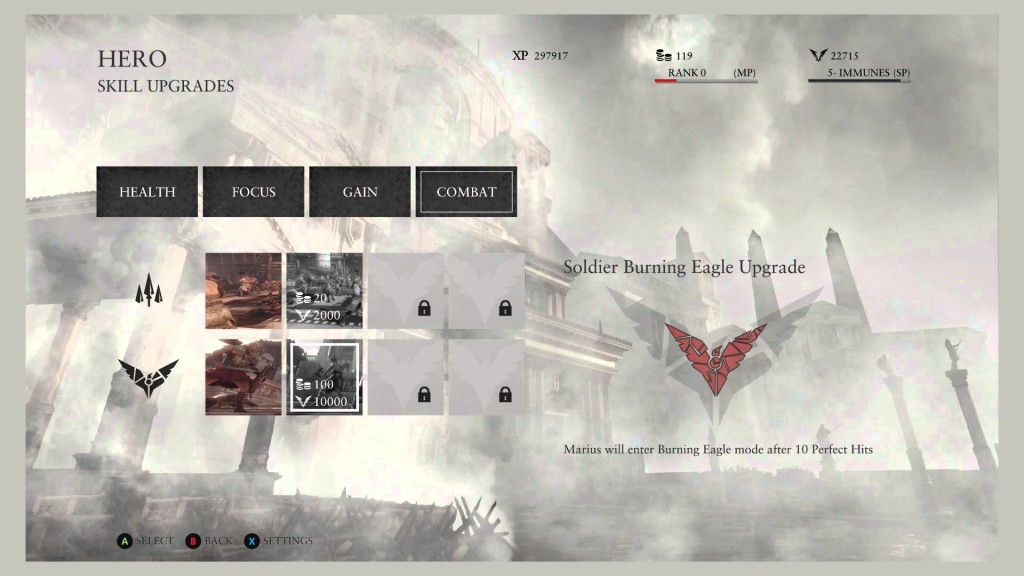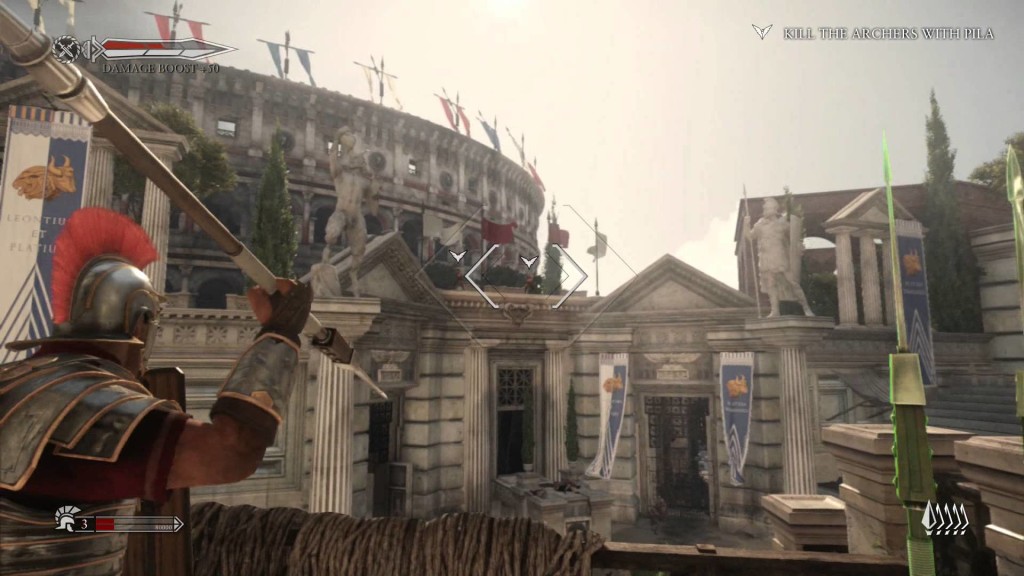Last updated on February 19, 2016
Part One
Further, making the decision of what kind of defensive measure you want to take plays into the primary mode of high level play: the combo system. Like in a standard combo system, each hit adds to the counter in the upper right hand corner of the screen. However, pressing each attack with perfect timing (that is, pressing an attack immediately after the last one hits) causes your attacks to come out faster, do more damage, and add more hits to the combo counter Hitting around 9-12 (depending on upgrades) of these “perfect hits” in a row puts Marius into Burning Eagle mode, which substantially increases your damage and combo counter for as long as your combo lasts.

So, the fundamental question is: why do I want to do these things? Usually, combos in combat-action games mean little except for scoring purposes, but Ryse gives them a functional, game related purpose. You may have seen them, since they were Ryse’s primary selling point, but Executions are the name of the game. After hitting an enemy enough times (depending on enemy type and difficulty), a skull symbol will appear above their head. This means that the enemy can be Executed by pressing the Right Trigger next to the enemy (it has a short wind-up time, so watch for enemies who want to interrupt you, but it’s invincible thereafter). The game will suddenly zoom into a quicktime event with a particularly grisly, and (admittedly) satisfying kill that requires you to guess the right sequence of X (denoted by the enemy glowing blue) and Y (denoted by the enemy glowing yellow). Executions also fall under the rule of the perfect hit (just hit them immediately when the button prompt appears), but are especially important, since the perfect Legendary hits here can up your combo gauge by up to three to four points each!

With the completion of a successful execution, that matches all the buttons presented, the game gives you an Execution reward, which can be extra health, experience points (used to buy health/Focus/Execution upgrades), Focus meter, or increase your damage for a limited time. The effect of these increase with good timing, although the enemy dies regardless if you initiate an execution. The difficulty of standard encounters often means you’ll need to pick an Execution bonus that best fits your current situation, and that will vary from player to player. I like the option to choose which one I wanted (for me, I just chose XP, since I wanted to unlock every upgrade, but you might find something else more useful).
Some players, just for example, might find themselves having trouble with shielded or dual-wielding enemies. As such, they might want some additional Focus generation. Pressing the Right Button causes Marius to enter Focus mode, which breaks every enemy’s guard (in a certain radius) and begin Flurry attacks, which buff the combo meter and usually kill the enemy in question (if not placing them in Execution state!). The meter builds slowly enough that the Execution Perk for focus might become useful, and the game lets you change your bonus on the fly! This system gives players an incentive to do Executions, and do them well; while animations repeat, there are enough of them, and they are satisfying enough, that I really never got tired of them. They vary by enemy positions, and there’s a ton of them. Add Double Executions to the mix (get two enemies to skull status, then press execute), and you get double the fun for double the bonus!
Even with all of this, I haven’t explained why you want to keep your combo meter going. True, you get additional Execution bonuses, but a exemplary combo often provides you with loads of experience points to upgrade your character. Upgrades don’t consist of new moves, but consistent combos reward you with tons of health, Focus, and new Executions which generate more of the resource they are attached to. Hence, this is why I mostly focused on XP as a perk for the majority of the runs, as I’d get a massive XP bonus from literally every combat scenario. The game’s challenging regardless (at least above the standard difficulty, since I went straight to Centurion, i.e. Hard), but who doesn’t like extra challenge? Note, as well, that taking a hit completely resets the combo meter, and drops Eagle status! These are both massive punishments for failure, and the game clearly wants you to avoid this. So play well!

Even with that caveat, there’s plenty of challenge should you choose to progress to Legendary difficulty. The game removes the red attack tells, and also makes enemies take out heaps of damage (and taking a ton themselves), so learning the combat system is essential to staying alive for more than a few seconds, even with upgrades!
The only thing that really confuses me about Ryse’s design, and that I dislike vehemently, is the pilum. You active them by holding the Left Trigger, and then pressing the Right Trigger for a quick throw, or holding the Right Trigger for an aimed throw. These are just spears, that you can throw. They kill enemies in 1-2 hits, and you can aim them (which takes time for some white lines to go across some red lines as you hold). The intent, far as I can tell, is to make you deal with ranged enemies, but it’s just not very interesting and feels very clunky. Marius takes forever to get into pilum position, and by the time you do it you might have to roll out of an enemy arrow’s range or deflect it (which sends the arrow back and kills them – it’s funny, but weird).
The game also doesn’t mention when you run out of pilum or telling you to grab more, which left me sitting there looking like an idiot more often than not if I didn’t check the tiny indicator in the bottom right corner. Also, grabbing that ammo off dead soldiers and the ground is way more precise than it should be; if you press A, Marius hits his shield normally, so if you’re not close enough to the pickup he does that here too, taking precious seconds away from hitting enemies. This is especially important on Legendary, where one misstep in a pilum section often leads to a Game Over. So yeah, I’m pretty raw about pilum, which is really an awful mechanic and has no place here. The turret/ballista stuff is fine, but it’s as out of place as pilum, really, since no ballista in real life can reload that fast and it looks goofy. Thus, you gotta deal with a feel crappy “cinematic” segments in-between combat, but if I can get through it you can!

There’s also another strange subsystem only used in the campaign, wherein you lead a battalion of troops in formation to either advance or kill some barbarian via the use of pilum. In the Xbox One version, these segments require voice commands (if you happen to own a Kinect version of the console), or via simple button commands. I imagine that version provides a more visceral, engaging experience, as pressing the buttons doesn’t really do much. I think of it as a pacing tool more than anything else, although a few of these segments are quite difficult for some reason. Honestly, they’re facile enough that there’s not much to critique; they’re just there, and again distract from the combat.
